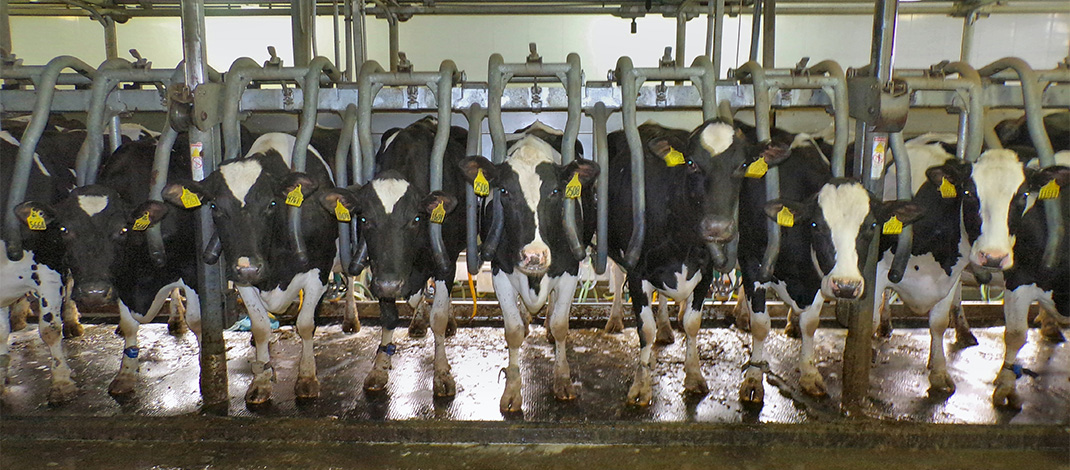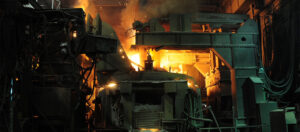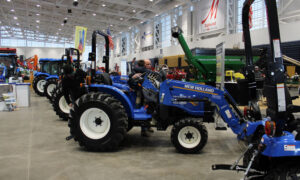Tucked between Pulaski and Mannsville lies a $60 million dairy farm operation, one of the largest in New York state
By Stefan Yablonski
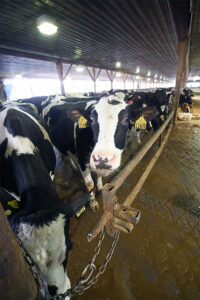 What do you hear when you walk into a barn full of thousands of cows? Nothing —nothing at all. The scent is rather pleasing as well.
What do you hear when you walk into a barn full of thousands of cows? Nothing —nothing at all. The scent is rather pleasing as well.
The four-legged denizens of North Ridge Farm are quite content. They chewed their cud and munched on feed, nonplussed by a recent interloper.
Locust Hill Farm was founded on Christmas Day 1975 by Timothy and Renee Alford. They started their Mannsville farm with 39 cows and 165 acres.
Today, Locust Hill Dairy LLC is a family dairy farm with four locations, 5,000 cows, 2,800 heifers and upwards of 5,500 crop acres growing corn silage and hay. It’s one of the largest dairy operations in New York state, generating revenues of about $30 million a year.
The Pulaski–Lacona area location is dubbed North Ridge. From the barns, one can view the cooling tower at Nine Mile Point and some awesome sunsets.
The Alfords converted the business to an LLC to bring in the members of the business’ next generation — their two daughters, Jessica and Amanda and their husbands, Bruce Gibson and Brian Muto, respectively.
In 2015, the Alfords built another dairy with a larger milking parlor. When both facilities are at capacity, they can milk more than 4,000 cows, generating 135 million pounds. of milk annually or about 16 million gallons.
Bruce Gibson is a managing partner of Locust Hill Dairy Farms in Lacona and Ellisburg. He served as my tour guide recently.
“There are six of us on the farm that are partners. We are all active managers on the farm in different areas,” he explained. “When it comes to day-to-day operation of the farm, between my wife, myself, my brother-in-law and his wife —we do all the heavy lifting day in and day out.”
His mother-in-law and father-in-law — Renee and Tim Alford, the founders of the business — are in their early 70s, he added.
“They are still active in the farm; I’d say in a strategy role, a consulting role. I think Tim’s in the barn early every morning,” he said.
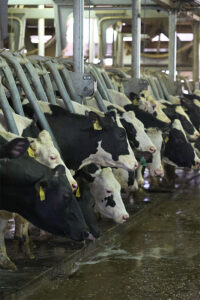 The Alfords now have time to do all the things they didn’t have time to do when they were younger and growing the business, Bruce added.
The Alfords now have time to do all the things they didn’t have time to do when they were younger and growing the business, Bruce added.
“They just got back from a week in Texas. They went to Oregon a couple of weeks ago. They are active in their hobby — quarter horses; maybe four or five years ago that wasn’t true,” he said. “They aren’t working 80 hours a week like Brian and I. The six of us, I would say are all on equal footing.”
“I didn’t grow up a farm girl. My husband and his family were a farm family,” Renee Alford said. “We never thought we’d go from around 40 to thousands of cows. We didn’t start out with a plan — but here we are today.”
The business consists of four places actually.
“We have three milking facilities, dairy farms, and one heifer facility. I think we are right around 70 employees. That’s probably one employee to every 70 cows, give or take,” he said.
Bruce Gibson is also the president of the Oswego County Farm Bureau board. He came to the farm in 2015 after a career as a computer network engineer for a large IT company, he said.
The majority of the dairy’s farmland and livestock are in Oswego County.
The dairy is a member of the Cooperative Dairy Farmers of America (DFA) — the largest cooperative in the United States. There are somewhere around 12,000 dairy farmers that are the farmer owners of DFA. In the northeast it used to be called Dairylea, which merged with DFA.
Predominantly, the farm provides products in New York state to Hood, Chobani and Great Lakes Cheese in Adams. About 99% of all their milk goes to Great Lakes Cheese, Gibson said.
Pandemic trouble
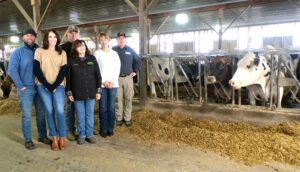
They had to dump a lot of milk at the start of the pandemic.
“It was hard — but it was hard for a real short time. It was really hard for a short time and then it was hard for the rest of the year, 2020,” Gibson said.
“What happened in 2020 for us was about a week we had to dump a tractor-trailer load of milk. That’s about 500,000 pounds of milk. In gallons that’s about 56,000 gallons. We dumped for a week,” he continued. “A lot of farms dumped for that first week of the shutdown. A lot of that was trying to figure out across the supply chain what the reality was going to be. The logistics people inside of DFA and the various processors, like Great Lakes, like Hood, like Chobani — they kind of made some guesses about what they needed to do. And, I think they turned out to be some pretty good guesses. As a result of that part of the pandemic we did have to reduce our milk output by about 20%.”
Since then, they are probably not back to where they produce all of the milk that they did pre-COVID-19 — but it’s not all that far off, he said.
“It changed the milk production business — it changed dairy farming. COVID changed dairy farming probably forever. It changed how the supply chain works and it changed how processors think about their production systems,” he said.
A lot of production in Central New York for ingredients for like sour cream and yogurt — and to a certain degree milk and cream — they were geared toward institutional customers: restaurants, schools, universities, hotels and cruise ships. Those were the packaging sizes geared toward those size quantities; and not necessarily toward the consumer. Part of what was challenging in the first weeks of COVID-19 was figuring out that production needed to shift to the consumer from the institution.
Those processors worked very quickly to try to make those products that consumers could have delivered or picked up at the grocery store or curb side from the grocery store; as opposed to like 25-pound tubs of sour cream, he said.
“The industry wasn’t quite as nimble as it needed to be. But I think that as a result of COVID, those processors are more in tune with things now,” he said. “I think that when a food system is put under that much stress, you’re going to figure out where your strengths and weaknesses are.”
Life goes on
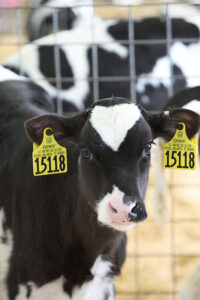 “Day in and day out on the farm, life changed very little for the dairy farmer — or any farmer really. The cows need to eat every day. The cows need to be milked every day. The pandemic really didn’t matter much on the dairy,” he said.
“Day in and day out on the farm, life changed very little for the dairy farmer — or any farmer really. The cows need to eat every day. The cows need to be milked every day. The pandemic really didn’t matter much on the dairy,” he said.
Bruce Gibson and Brian Muto start out every morning at no later than 4:30, typically at the two largest dairies.
“We’re going from then right through 5:30 or 6 most days,” Gibson said. “Brian usually takes off Sundays and I have Saturdays off. One of the two of us is always around.”
“We really don’t quit. We’re at it 365 days a year. No time off for good behavior,” said Renee Alford, laughing..
The task of the morning is about getting set for the day, Gibson added. They do a shift change at 5 o’clock in the morning. The day crew is probably 50 of the farm’s 70 employees. The other 20 are at night.
Probably the most significant task is getting the feed situation for the cows aligned.
“We make sure those 50 men and women know what they are doing that day. Because all of the cows — at all four facilities — are fed a specific diet depending on their needs; whether they are a dry cow or a milking cow. So we go through that information to make sure that our cows are taken care of,” he explained. “It is all very scientific. We make sure that our feeding software has the right information — up to date for that day’s feeding on all four operations.”
Today is “nutrition Monday.”
They have a nutritionist whose job is to create the diets for all of the animals. They test all of the feed they use — test it for nutritional content.
“And she literally writes a recipe for all of the cows. We have feeding software that that recipe gets entered into. For example, for a milk cow she writes a recipe that has how much hay they get, how much corn silage they get and so on,” he explained. “The other ingredients we put in there are cornmeal and they also get grains. There is typically protein in there and then we also add liquid whey — a nice source of sugar for the cow.”
Their feeding software puts that recipe on a little USB key a thumb drive and it is plugged into a feed chart and it tells the feeder: go to the corn silage and put in X number of pounds of corn silage and then go to the hay and put in exactly this much hay, go to the grain bin and put in X number of pounds of grain and then it tells you’re going to mix this mix for five minutes It tells the feeder to drive to ‘this pen’ and feed out exactly this many pounds to these cows.
“It’s all very, very highly controlled,” he said.
Technology
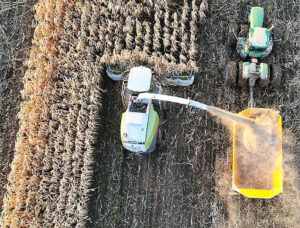
Every cow wears a FitBit on its foot. It IDs the cows for health information, like standing time, lying time and it also tells how many steps they take in a day.
“It builds a profile for that cow. If the cow’s behavior changes outside of the parameter of her normal, then we get notified — ‘this cow was lying down two hours more than she normally does,’ for example. The most common example is ‘this cow is 40% more active in terms of taking steps’ — that tells us she’s probably heat,” Gibson said. “We use that to generate alerts for the herdsmen to take a closer look at certain cows. The other thing, it identifies the cow when giving milk so we know what milking parlor stall she was in, what time the milker went on, what time it came off and how many pounds of milk she gave in between. It’s all closely monitored on a per cow basis. Thanks to modern technology, the [thousands of] cows are healthier these days than the first 40 that Tim started with years ago.”
The computer program keeps track of every cow and what’s going on with them. It tends to be used more for post mortem — when something goes wrong.
“If something gets messed up somewhere, this alerts us. For instance, something went wrong last night. I had to look at the video to figure out what it was. Someone didn’t unhook a sample. We draw a milk sample — but he didn’t unhook it before we washed the parlor,” Gibson said.
They now have so much information about each individual cow that they are actually managing these cows and treating these cows as individuals again, he added.
“It’s kind of like back when Tim had 40 cows when he first started. He knew every cow by name and he knew everything about every cow. Even though we have 5,000 cows we know everything about every one of those cows. So we are able to make individual decisions about the health and well being of every one of these cows,” he explained.
The cows all get their hooves trimmed every year. Every cow, times four hooves — times twice a year — “that’s a lot of maintenance,” he said.
The cows are just being cows right now, said managing partner Brian Muto as we wandered past dozens that were eating their feed.
“That’s the sign of a content group of cows,” he said as the cows barely glanced at us.
“If they’re not content you’d hear them bellow. They are into their routine. This group gets fed every morning 10, 10:30. So if it gets to be 11 o’clock and this feed wasn’t here they’d let you know vocally. ‘Hey, why isn’t my feed here yet?’” Gibson added.
“We keep pushing the feed up so they have a clean plate,” Muto said. “That’s made up of six or seven different ingredients. There’s a lot of straw in this diet (for the dry cows). The pregnant cow that isn’t milking doesn’t need the energy that a milking cow does. You want to fill her up, just get her the nutrients that she needs so she doesn’t get too fat.”
“We feed, between all the milking facilities, somewhere between 180 tons of corn and say somewhere around 75 tons of hay, 35 tons of cornmeal,” he said. “That all gets mixed together. All the groups have three water troughs. Some have more, depending on the number of cows.”
The only thing that interrupts the cows’ solitude is the periodic arrival of the cleaning truck. Muto described it as like a street sweeper or a Zamboni —but instead of cleaning an ice rink, it removes the waste from the barn. The cows don’t pay any attention to the noisy vehicle. They just go about their business.
“The cows are all so well behaved — they go to school,” Renee Alford quipped.
The barns are reminiscent of an Iroquois longhouse. They are 700 feet long, Renee said.
Each contains upwards of 900 cows; there’s probably 1,000 head in each one, according to Alford.
Huge fans ensure the cattle are warm in the winter and not too warm in the summer. Newborns have their own area with a heated floor and a shelter where they can dry off.
Scores of cows wander down and take their place at the milking stations. Many more follow and patiently wait their turn. When the cows finish milking, the milker automatically kicks off and the cows head back down the barn as the new group takes up position. It’s a well choreographed daily ballet.
The dry cows have a red band affixed to their legs. That way, if one managed to make its way to the milking parlor they’d be spotted and returned to their rightful place.
The milk comes out of the parlor and is piped into the milk house, into a vat and eventually into a tanker. It’s never exposed to air. Computers keep track of how much milk each cow produces. Also, samples are taken during each milking to ensure quality. If any impurities are discovered, that batch is discarded.
All of the milking equipment is cleaned after each session.
Towels are washed and dried in large washer and drier every day. “We use the towels to clean the udder before we milk the cows — before the milker goes on,” Alford explained. “It’s a little stimulation there to get them started.”
“Nutrient management”
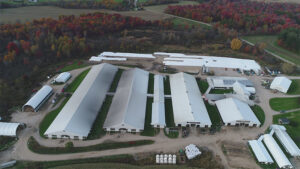
“It is a nutrient for our crops — it’s probably the most important nutrient that we have. And we actually don’t have enough manure to cover all of our acres,” Gibson said. “We are cropping directly or indirectly (we have a couple of farmers who crop some land for us) about 9,000 acres.
“So 7,000 acres of that is what we are cropping directly. Our crop team is doing the planting and harvesting and manure spreading etc. The other 2,000 we might supply some manure to those acres, but another farmer is custom growing those crops for us.”
It’s a complete cycle; cows produce the waste — it is used as fertilizer to help grow crops and then the cows eat that food, he explained.
What is the most important aspect for a farm this size?
Everything —it’s like a great big wheel — if one spoke breaks, the wheel doesn’t operate correctly, according
to Gibson.
$30 Million Annual Revenue
Locust Hill Dairy LLC represents about $60 million of investment in land, buildings, livestock and equipment. Annual revenues are about $30 million, a figure that fluctuates dependending of the price of milk. Most of business’ revenue is returned to the local business community in the form of payroll for 75 employees, purchased equipment, land leases, purchased feed, supplies, taxes and spare parts of all kinds.
3 Myths of the Large Farm
1 — Family vs Corporate Farms
One of the things the owners of Locust Hill Dairy want people to understand is that large farms in New York state are family farms.
“There really aren’t very many “corporate” farms in the U.S. and very few, if any, in New York. Our farm is large, but it is owned and operated by our family and our employee family as well. Our employees include a number of brothers and sisters, fathers and sons, and cousins. One of our milk truck drivers has a grand-nephew that works for us,” managing partner Bruce Gibson said.
2 — Caring for the Livestock
Another myth is that large farms mistreat their livestock.
“That’s completely false. Our motto is ‘Cows come first.’ Every single thing we do on the dairy is to ensure the cows are content. Unhappy cows do not produce much milk. Happy cows make a lot of milk, he continued. “If you want to get yourself fired from Locust Hill Dairy, mistreat a cow or a fellow employee. The public doesn’t know it, but our farm, and most all dairy farms, voluntarily comply with, and exceed, a set of cow management protocols called F.A.R.M 4.0. FARM stands for Farmers Assuring Responsible Management. Our farms are audited periodically by our cooperative and independent auditors to ensure we meet all health protocol, training and documentation requirements. It’s a substantial amount of work, but it is important. We want consumers to know that we care deeply about our cows. If I am reincarnated as a cow — I want it to be at our farm.”
3 — The Antibiotics in Milk Myth
One of his least favorite myths is that there are antibiotics in milk, Gibson said.
“We test all our milk for antibiotics before it even leaves our farm. It’s tested three or four more times after it arrives at the processing plant,” he explained. “There are no antibiotics in milk.”
More Time for Quarterhorses
Timothy and Renee Alford’s main hobby is quarterhorses. They participate in RCHA — Reining Cow Horse of America — attending several competitions throughout the season. This has given the couple the opportunity to travel to Arizona, Ohio, Oregon, Texas. Locust Hill Farm also hosts sanctioned US Cutting Horse Association events in the summer.
13.5 Million Pounds of Cheddar
Milk produced by Locust Hill Farm is made into 13.5 million pounds of cheddar. The average American eats 10 lbs of cheddar per year, so milk from the local operation provides one year of cheddar cheese for 1.35 million people.
Building it From Scratch
Locust Hill Farm is nearing its 50th anniversary. The business was founded on Christmas Day 1975 by Timothy and Renee Alford, who remain principals in the operation.
Fifty years is young in some respects —some New York state farmers are six or seven generations on their land, according to Bruce Gibson, a managing partner.
However, 50 years is impressive when you consider that Tim and Renee Alford literally built this from nothing, he said.
Tim Alford does descend from a long line of dairy farmers, here and in England. However, when it came time to start the farm, they did it all.
The Alfords saved the money, bought the farm and cows and grew it themselves. The ability to adapt, take risks and change in a rapidly changing industry is what has made the dairy farm successful, according to Gibson.
Tim and Renee realized in the early 1990s that the industry was consolidating and they felt that growing the business was going to be key.
This spirit of evolution continued when Brian and Amanda (Alford) Muto joined in 1990.
New York state was becoming the yogurt state and cooperatives were looking for milk supply. The four of them (Tim, Renee, Brian and Amanda) planned and executed an expansion that became North Ridge Dairy in Lacona.
The expansion took the farm from about 1,400 cows to 3700 cows.
After Gibson and his wife, Jessica (Alford), joined in 2015, in part to help complete North Ridge, two opportunities were presented to the farmers in the form of Deer Run Dairy and Morning Star Farm.
Having an ownership team with diverse personalities and skills allowed them to grow the business successfully.
Also, attracting and retaining the best team of employees in the dairy industry is essential.
The short answer, Gibson said, is that in modern agriculture you have to have the ability to adapt to adversity, change to meet it and have the stomach for risk. (SY)

